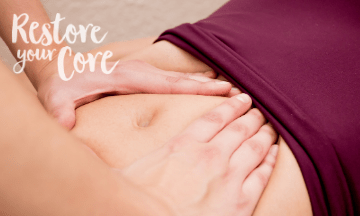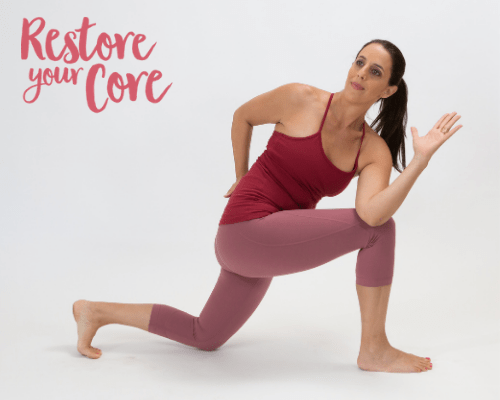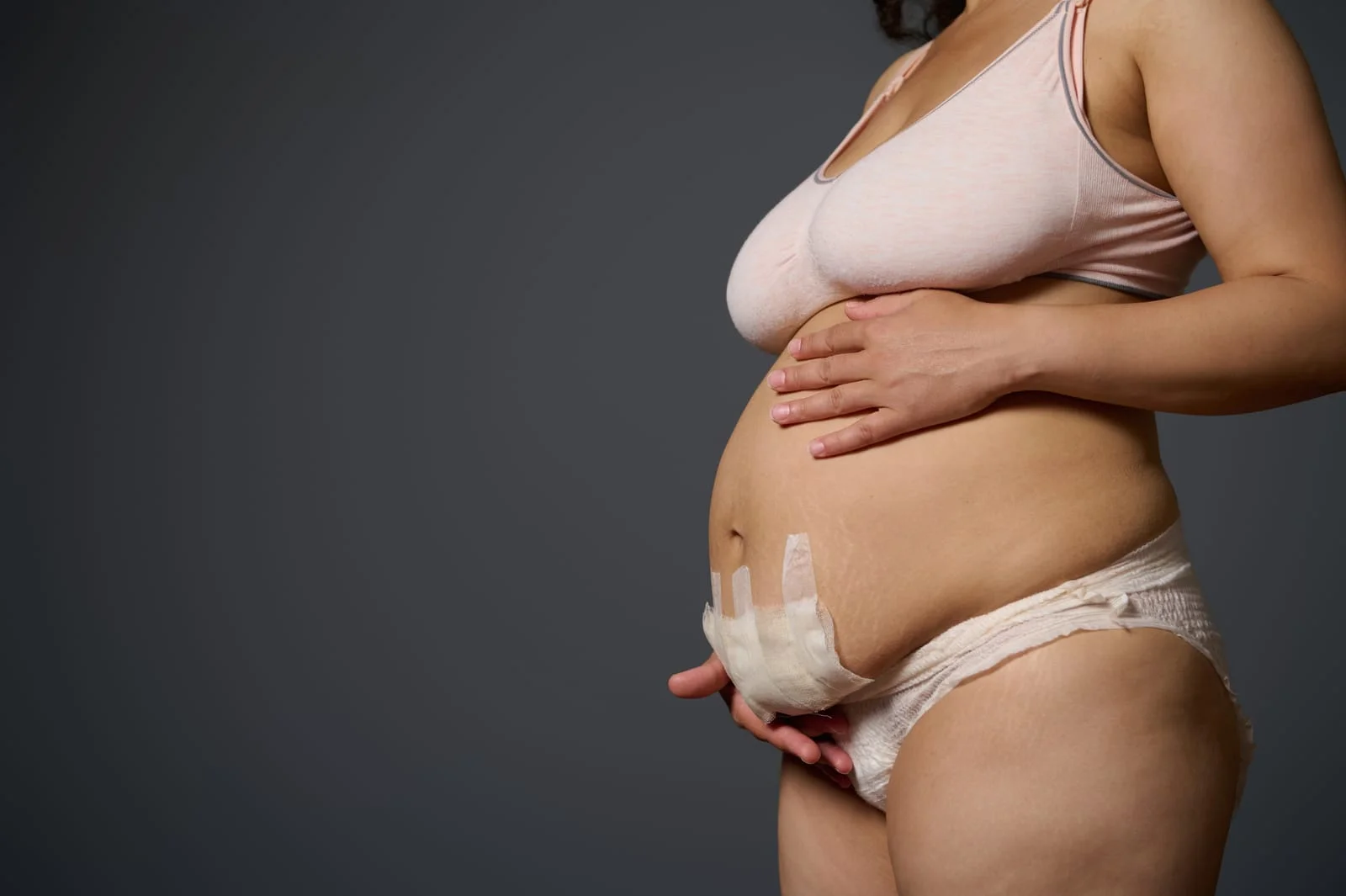
Lauren Ohayon is the creator of Restore Your Core® (RYC®), a comprehensive and sustainable whole-body fitness program that empowers women to achieve ideal pelvic floor / core function and be strong, long, mobile and functional.

Post-pregnancy pain, whether it be pelvic floor pain or joint pain, is a shared experience among many postpartum people. However, postpartum pain, especially in pelvic pain, can vary in frequency, length, and intensity. Some people may only experience short-term pain that lasts the first 4 – 8 weeks of their recovery and others may suffer from pelvic pain for up to or over a year after they’ve given birth.
Pelvic organ prolapse and other forms of pelvic floor dysfunction are very common among postpartum people. Symptoms can vary in duration and severity, but many women are likely to experience a variety of symptoms during and after their pregnancy. At Restore Your Core, we’ve noticed similarities in many of our client’s stories. Some of the most common pelvic floor complications our clients experience include:

Pelvic floor pain can be treated and relieved in many ways. Whether you visit a pelvic floor physical therapist or take part in a program like Restore Your Core, movement specialist or your physical therapists will utilize exercise methods designed to strengthen and restore function to your core, pelvic floor muscles, and relieve any painful symptoms you may be experiencing.
In this article I will attempt to address the most commonly asked questions regarding pelvic pain after giving birth.
Get free expert advice and start your postpartum healing journey today
Table of Contents
After giving birth, your pelvic floor and core muscles will be in the process of healing for at least a year. Although many women may begin being active again after the first 8 weeks postpartum, often pelvic pain and the symptoms of diastasis recti may be experienced for months postpartum. Both your core and your pelvic region have gone through significant changes in order to accommodate your baby. Attempting to quickly get back into an exercise or workout routine may be unhelpful in your recovery – especially if you are already experiencing complications or painful symptoms.
Every postpartum person is different and the recovery length can change depending on many factors. Healing can take anywhere from a few months to over a year, depending on whether or not there are underlying conditions which may be increasing the pain. While there are no overnight success stories, there are many many success stories of people like you who have healed their pelvic organ prolapse by taking these steps slowly and surely.
Take 3 steps toward doing the things you love again postpartum
Yes! Postpartum pelvic pain is very common. During childbirth, your ligaments and joints become loose as your body is adapting to your child’s weight, abdominal separation, and increased heaviness in your pelvic floor. It is common to experience pain in your pelvic girdle, hips, and joints as a result. Light recovery exercises and movement can also cause minimal pain as you begin strengthening your pelvic floor muscles. Seeing a pelvic floor physical therapist or enrolling in a yoga or postpartum exercise program can help relieve urinary incontinence, back pain, and other postpartum pelvic issues.
Pelvic floor physical therapy can be a great treatment program for you and your postpartum pain. A pelvic floor therapist will help create an individualized plan to help target your specific symptoms, condition, and your own recovery goals. Similarly, Restore Your Core can help you become a part of a community of people focused on health and function without promoting unnecessary, culturally influenced slim body programs. Our Restore Your Core Program will help relieve any postpartum pelvic pain, provide treatment options involving exercises for symptoms (i.e. urinary incontinence, pelvic, back, and core pain), education regarding proper breathing patterns, posture, and poses, as well as additional tips and guidance on how to safely and effectively recover from postpartum pain.
Discover the top 3 steps to regain your fitness and strength postpartum–free
Pelvic floor physical therapy treatment options may vary depending on the severity of your condition. If you decide to see a physical therapist, you’ll have an initial assessment to determine what treatment will be best. An assessment can include vaginal and rectal manual palpations. Palpations can help determine the strength of your core and pelvic floor muscles, areas of tenderness and pain, as well as muscle tightness.
We do not offer physical therapy, but movement therapy. Restore Your Core specializes in exercise treatment as well as education for women suffering from pelvic floor pain and any other postpartum issues. Below is a list of several exercises we cover in our program.

This stretch is an incredible hip and pelvis stretch. Grab a low stool or a stack of books and with your feet spread wide and toes pointed out sideways, gradually extend your buttocks and lower yourself to the blocks. If you are struggling to balance yourself, it may be helpful to use a wall for back support. It is important that if you experience any discomfort during these stretches that you reposition yourself until you can firmly plant your feet and bend without pain. Stay in a squatted position for close to 30 seconds (5-10 deep breaths), stand back up, relax, and repeat several times. Please note, that for some people with prolapse – a deep squat can really irritate and aggravate things due to bearing down, so be sure to only do this one if you feel comfortable that you are not bearing down in a low squat.
This stretch is an incredible hip and pelvis stretch. Grab a low stool or a stack of books and with your feet spread wide and toes pointed out sideways, gradually extend your buttocks and lower yourself to the blocks. If you are struggling to balance yourself, it may be helpful to use a wall for back support. It is important that if you experience any discomfort during these stretches that you reposition yourself until you can firmly plant your feet and bend without pain. Stay in a squatted position for close to 30 seconds (5-10 deep breaths), stand back up, relax, and repeat several times. Please note, that for some people with prolapse – a deep squat can really irritate and aggravate things due to bearing down, so be sure to only do this one if you feel comfortable that you are not bearing down in a low squat.
Get 3 (free) scientifically-proven steps and regain your postpartum strength and fitness
This exercise offers a lot of people relief from their symptoms and it is a great way to downtrain the pelvic floor. I always teach this with a block / pillows / blankets under the hips for elevation. The elevation is pretty key so be sure to get your hips on something. Elevate your hips and simply bring your legs up a wall. Move closer or further away from the wall depending on your body and comfort. Stay for 3-4 relaxing breaths and then you have a few options. One is to bend your knees and have the soles of your feet touching while still leaning legs against the wall. Adjust your body to make this more comfortable. No stress or tension in your hips. The other is to simply bend your knees and place the soles of your feet on the floor and relax your pelvis and pelvic floor and finally, option #3 is to open your legs wide and keep them against the wall while straddled. Find the position that best allows you to relax and release. Hold for 5-8 breaths.

“There is no thank you big enough for Lauren Ohayon existing and thinking and helping so many of us. Every time I do something I never thought I’d do again she is part of the reason why.”
Laura Gregg
in this FREE video and get the support you deserve

Postpartum physical therapy can be a great way to restore function and strength in your core and pelvic floor muscles. Giving birth places a strain on your body and it...

The postpartum recovery period typically lasts well beyond common expectations. Guiding and supporting your postpartum patients and clients through this transitional period requires effective strategies tailored to their individual needs....

Postpartum recovery can be difficult for anyone, but there are particular considerations to keep in mind after a C-section. Read on to learn more about how to begin a safe...

Have you just had a baby, or are you about to give birth? Read on for pelvic floor exercises that facilitate faster postpartum recovery, enhance overall well-being, and improve long-term...

Introduction Pregnancy and delivery are a massive undertaking. Your body has to adapt and expand to allow the baby to grow, and having a C-section means you face a whole...

It is not uncommon for many postpartum people to experience complications such as pelvic organ prolapse postpartum. Vaginal and rectal prolapse occur when the supporting muscle and tissue structures become...

Giving birth takes a toll on your body – both physically and emotionally. Many postpartum people will feel overwhelmed and exhausted after giving birth, which can make it difficult to...

Before you begin any exercise routine, consult with your doctor for medical clearance. Practice patience with yourself and your body, and rest, lots of rest! I recommend waiting at least...

*No spam, just quality content and support
Please check your inbox soon.

Take 3 steps toward doing the things you love again postpartum
© 2025 RYC®. All rights reserved.
in this FREE video and get the support you deserve